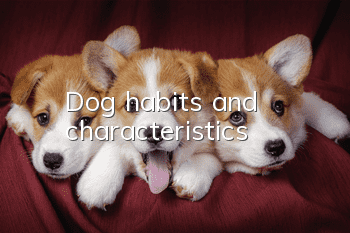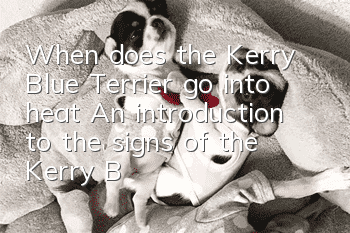Dog habits and characteristics

Sensitive sense of smell
The dog’s sensitive sense of smell is mainly manifested in two aspects: one is the sensitivity to smell; the other is the ability to distinguish smells. Dogs' ability to sense odors reaches the molecular level. For example, dogs can smell it when 1 cubic centimeter contains 9,000 butyric acid molecules. Under normal circumstances, there are about 268×10.e+16 molecules per cubic centimeter of air. Therefore, the concentration of butyric acid detected by dogs is 3.36×10.e-17. Dogs can still smell it when someone dilutes sulfuric acid to one ten millionth.
Sensitive hearing
Dogs can not only distinguish extremely small high-frequency sounds, but also have a strong ability to identify sound sources. According to some tests, its hearing is 16 times that of humans. Dogs can establish conditioned reflexes based on changes in pitch and syllables to human commands or simple language to complete the tasks assigned by their owners. Dogs can hear very soft commands without having to shout loudly. Excessively high sound or audio frequency is a kind of adversity stimulus to dogs, which makes dogs feel painful and frightened and even avoid them. Of course, stricter commands can be used to prohibit or correct a dog's wrong behavior.
Poor vision
Dogs are color blind. In the eyes of dogs, the world is like the picture on a black and white TV. Only the brightness of black and white is different, and the changes in color cannot be distinguished.
The adjustment ability of dog eyes is only 1/5~1/3 of that of humans. A dog's ability to perceive an object depends on the state of the object. Fixed targets can be seen clearly within 50 meters and cannot be seen clearly beyond this distance, but moving targets can be perceived as far as 825 meters away. The dog's field of vision is very broad. The left and right fields of view of a single eye are 100 degrees to 125 degrees, and the upper field of view is 50 degrees to 70 degrees. The lower field of view is 30 degrees to 60 degrees. It can see objects in front of it most clearly, but because the dog's head is very flexible, it can "see in all directions and hear in all directions".
Climb across
There are many indications that all animals transmit information telepathically, especially dogs. The relationships between dogs and dogs, humans and dogs, and dogs and beasts all have their own ways of transmitting information, either by changing the information or by completing the sensory information. For example, dogs often treat cats in a hostile manner, and dogs are very jealous of cats. However, through various human expressions and training, dogs can understand the owner's love for cats and live in harmony.
Typical examples of dogs with super-senses are: having premonitions before earthquakes and volcanic eruptions, running around outdoors and barking. Supersensory powers can also control dogs to identify directions and find their way home from far away places, even years apart. When a trained dog performs a task, it can already analyze the connotation of the owner's command and play its role well before the owner has even finished making a simple gesture or saying a sentence. This is the excellent dog training effect obtained by an excellent dog trainer. There is an unexplainable attraction between humans and dogs in joint activities - super-sensory related.
Digestive properties
Dogs can digest and absorb protein and fat very well, but their ability to digest crude fiber is poor due to insufficient chewing and short intestinal tracts that do not have the ability to ferment. Therefore, when feeding vegetables to dogs, they should be chopped and cooked and should not be fed in whole pieces or whole plants.
Dogs belong to the carnivorous order in animal taxonomy. The ancestors of dogs mainly preyed on small animals and occasionally used tuber plants to satisfy their hunger. After dogs were trained by humans, their eating habits changed and they became omnivores who mainly eat carnivores. However, they can also sustain life on a vegetarian diet.
Even so, they still maintain the digestive characteristic of mainly carnivorous. For example, a dog's teeth have a pair of sharp canines on the upper and lower sides, which reflects the characteristics of carnivores that are good at biting prey. The molars of dogs are also relatively sharp, strong and can cut off. When chewing food on bones, the pressure between the upper and lower teeth can reach 165 kilograms, but they are not good at chewing. Therefore, when dogs eat, they really "gobble it up" and rarely chew it.
There are abundant striated muscles on the esophageal wall of dogs and the vomiting center is developed. When poison is eaten, it can trigger a strong vomiting reflex to expel the poison swallowed into the stomach. This is a relatively unique defense ability. Dogs have well-developed salivary glands that can secrete large amounts of saliva to moisten the mouth and feed for easy chewing and swallowing. Saliva also contains lysozyme, which has a bactericidal effect. In hot seasons, the evaporation of water in saliva is used to dissipate heat to regulate body temperature.
Therefore, in summer we can often see dogs opening their mouths and sticking out their long tongues in order to dissipate heat instead of sweating. The canine stomach is abnormally pear-shaped, and the hydrochloric acid content in the gastric juice is 0.4~0.6%, ranking first among domestic animals. Hydrochloric acid can swell and denature proteins to facilitate decomposition and digestion. Therefore, dogs have a strong ability to digest protein, which is the basis of their carnivorous habits. Dogs can empty all the food in their stomachs 5 to 7 hours after eating, much faster than other herbivores or omnivores.
The intestines of dogs are shorter, generally only 3 to 4 times the body length, while the intestines of horses and rabbits, which are also monogastric, are 12 times the body length. Dogs' thick intestinal walls and strong absorptive capacity are typical characteristics of a carnivorous diet. The dog's liver is relatively large and secretes bile equivalent to about 3% of the body weight, which is beneficial to the absorption of fat. The dog's defecation center is underdeveloped and cannot defecate while traveling like other domestic animals.
Smell the external genitalia
The most important sense of a dog is its sense of smell. By sniffing each other’s external genitalia that best reflects emotions (the skin glands in this area can secrete an odor that is very attractive to dogs), they can identify the dog’s personality. Gender, age, physical condition and their attitudes. When two dogs sniff each other, they are making a statement. An older dog or alpha dog has the right to inspect the external genitalia of male dogs, female dogs, and puppies that are younger and subordinate to it. Both dogs have certain procedures when they come into contact, that is, first sniff each other, then touch the shoulder coat, and finally check the external genitalia. In addition to sniffing each other, both male and female dogs have the habit of frequently checking their external genitalia and carefully licking them with their tongues to keep them clean. This is dog health care and should not be opposed or reprimanded. When a dog sniffs its own rainbow frequentlyWhen the dog is in the portal area, it can be considered that the dog has discomfort and abnormal digestive function, and should be examined or treated in time.
Good to live in groups
Dogs are naturally gregarious, but they have a clear hierarchy in the group. In dog breeding farms, rural or suburban dog groups, there is always one leader dog (usually an old dog) who dominates and governs the entire group. How does a high-ranking or senior alpha dog show its rank advantage? It is usually expressed by the following specific actions: for example, allowing it but not allowing the other party to inspect its dog's reproductive organs; not allowing the other dog to pass over another dog. Urinate in the place where the dog urinates; the other party can shake his head or tail in front of the lead dog, play naughty, or retreat, sit down or lie down. Only when the lead dog leaves can he stand; after the level advantage is clear, the hostility is eliminated and they start to become friends. Dogs will display the same gesture toward their owners.
Easy to tame
It is a dog’s natural habit to interact with people, but its degree often depends on the degree of “imprint” contact with people at 3 to 7 weeks of age. If a dog is only with its parents or other dogs in the first two months of its life, and not with people, or does not really get to know people gradually, it will stay away from people throughout its life and will be difficult to train. If it is caressed by people since it is born, it will realize that people are friends and partners with whom it can play, and it will be familiar with people's smell, be kind to people, and can be easily trained. It is very important to pay attention to the marking stage when selecting and training a dog.
A sense of territory
Dogs, like other animals (such as cats, birds and rodents), have a sense of territory, centering on themselves, marking the territory with their own scent, and updating it frequently. A territory may belong to just one or two dogs, or to the entire pack. If an alien dog breaks into a dog's territory, it will act very cautiously. If the owner (dog) of the territory comes, the intruder will not dare to look at it, pretend to be busy with other things, avoid fighting with the territorial dog, and then leave. go.
So, how does a dog mark its territory? It usually fixes some points along the route it usually walks. For example, when a male dog goes out for a walk, he always pees a small amount of urine on some fixed tree trunks, under street lights or in corners. The scent of one dog can let another dog know the status of the dog's territory, gender, age and health. Interestingly, when a small dog passes through the territory marks left by a larger dog, it will try to raise its hind limbs to urinate to cover the marks left by the larger dog. When a large male dog passes through the marks left by a small dog, he will try to urinate in a lower than normal position to cover the marks left by the small dog.
However, the territorial sense of female dogs is not as obvious as that of male dogs. During her estrus period, she uses urine to mark the boundaries of her territory or mark the roads in order to tell the surrounding male dogs that she is in estrus. Usually, female dogs do not protect their territory and their status in the pack like male dogs do. Female dogs only pay attention to protecting their own puppies. There are many female dogs that can always live together in harmony and even feed other females. Dog pups.
- What should I do if my Samoyed has lochia after giving birth? How to deal with postpartum lochia in my Samoyed
- When does a Labrador go into estrus? How to care for a Labrador during estrus
- Introduction to Anatolian Shepherd Dog Prenatal Preparation
- Why do dogs die after eating chocolate?
- How to deal with postpartum lochia in Anatolian Shepherd dogs
- Is it good to neuter your Kerry Blue Terrier? What are the advantages and disadvantages of neutering your Kerry Blue Terrier?
- How to care for your Irish Soft-Coated Terrier during pregnancy Share tips on caring for your Irish Soft-Coated Terrier during pregnancy
- What should Russian Borzoi eat during pregnancy? Diet and care methods for Russian Borzoi during pregnancy
- How to care for a Labrador after giving birth. Tips on caring for a Labrador after giving birth.
- What are the prenatal signs for Czech Terriers? Introduction to Czech Terrier prenatal preparations



